Sputversary
(Updated with addendum at bottom on December 17)
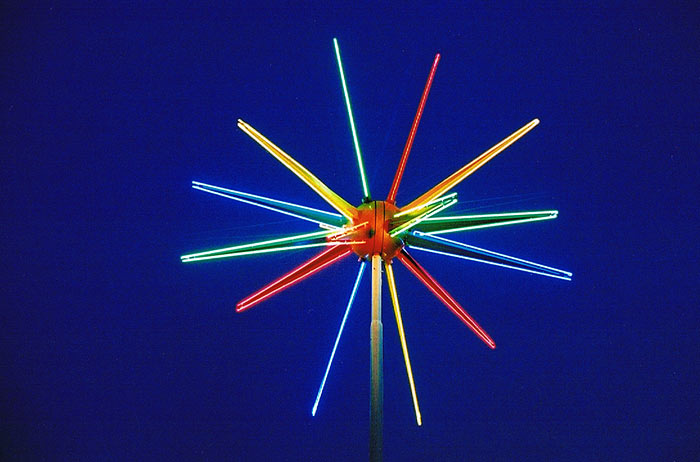
Impressive; isn't it? And it moves too, as I'll show you later. Its builder called it a Roto-Sphere, but it and its spiky signage relatives are more commonly known as "sputniks." This one graces the El Comedor de Anayas Restaurant in Moriarty, New Mexico.
I fell under the whirling neon spell of these things 29 years ago after travelling to a Yes concert in Tulsa, Oklahoma. Granted, I was the impressionable age of 16 and the smoke drifting about the auditorium might have made things seem a bit more cosmic afterwards. It had disappeared from the Tulsa skyline by the early 1980s, but that spinning UFO-like wonder sure left an impression on me.
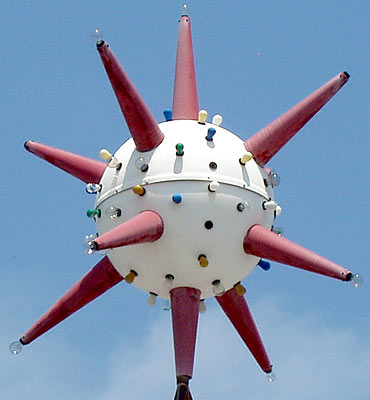
In recent years, while photographing roadside architecture, I would see the general form of the spiked ball repeated every so often, and much of the time locals would refer to the sign as a sputnik, as with this sign on the Bel-Aire motel in Springfield, Illinois on Route 66.
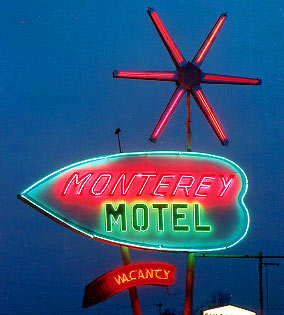
I would often see two-dimensional signs like this one, at the Monterey Motel in Choteau, Oklahoma, and wonder if they pre-dated the sputnik signs or if they were a less-expensive alternative that came after. Most such businesses have been through more than one owner, and obtaining precise age information is problematic.
With the 50th anniversary of the launch of the real Sputnik being October 4, I decided to try to find out two things:
1. Was the design of spherical and spiked roadside attention-getters really inspired by Sputnik?
2. Did the use of the label "sputnik" to describe these things originate "back in the day" (late 50's - early 60's) or was it a case of retro-naming by present-day googie and roadside aficionados.
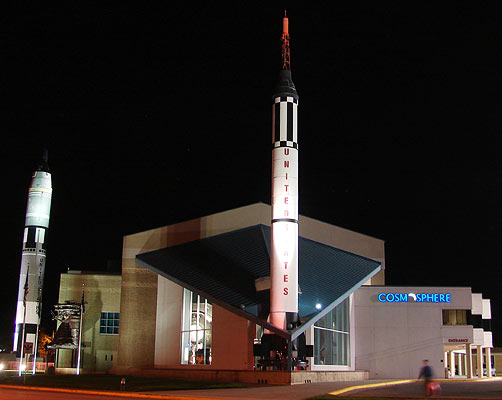
My first step was a trip to my local space museum (What? You don't have a local space museum?), the Kansas Cosmosphere and Space Center in Hutchinson, Kansas, to refresh my memory of Sputnik.
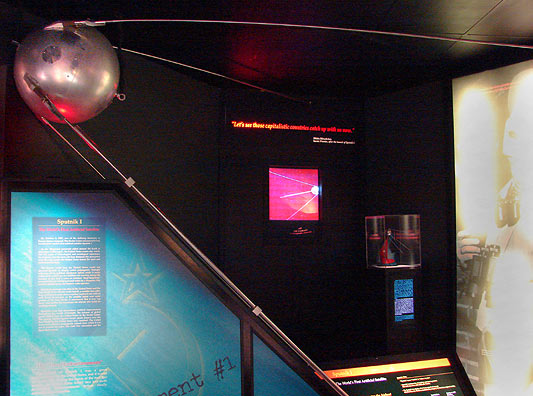
This is an actual back-up unit, which the museum obtained from the Russian manufacturer that built the original satellite. Notice that, although it is a sphere with spikes, the resemblance to the Roto-Spheres and such ends there, as Sputnik's spikes are four trailing, almost parallel antennae.
By the way, if you're one of our younger readers and don't know about Sputnik, or you're just not up on the space program, there is a plethora of historical information about it online and elsewhere. I recommend you look at NASA's account, wikipedia's overview of the Sputnik program, wikipedia's account of Sputnik 1, Roger D. Launius' excellent framing of the politics of Sputnik and Retired Bell Laboratories and Microsoft Researcher, Don P. Mitchell's history of the planning, construction and launch of sputnik 1, with three different audio files of the signal included.
The most poetic fact - to me anyway - is that for millions of years of life on Earth, the heavens were unsullied with anything from the planet's inhabitants, and the only satellite was the moon.
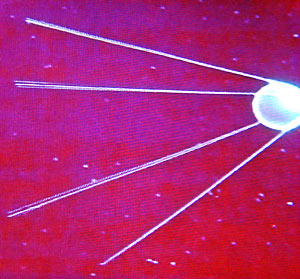
Fifty years ago tonight, Sputnik changed that with a "beep-beep-beep-beep-beep" that was music to Russia and a taunting "nah-nah-nah-nah-nah" to the USA. You can hear an audio file of Sputnik's signal at the NASA website. Give it a listen and imagine the hoards of ham radio listeners hunkered in their basements in wonder and fear.
Back to the subject at hand, if Sputnik itself did not influence the forms of the spiky and spherical signs known as "sputniks", what did?
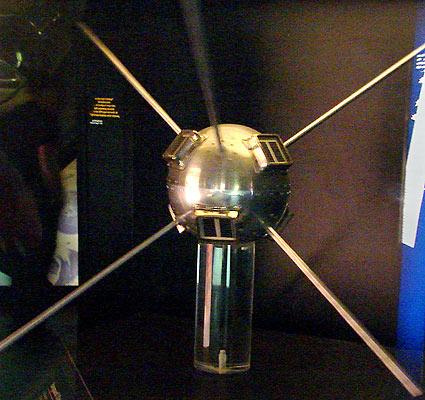
Meet Vanguard 1, one of the United States' early responses to Sputnik. According to signage at the Cosmosphere, the first Vanguard satellite was launched December 6, 1957 and did not go so well. In fact, the rocket carrying it blew up on the launch pad. Ten more Vanguard attempts were made after that, only three of which were successful. However the satellites did provide some of the first data on solar radiation and its effect on Earth's atmosphere and, unlike Sputnik, the three Vanguard satellites that made it into space are still there almost 50 years later. This particular one is a working unit built as a back-up for Vanguard I. It was scheduled to be launched on a later flight, but the program was cancelled before this happened.
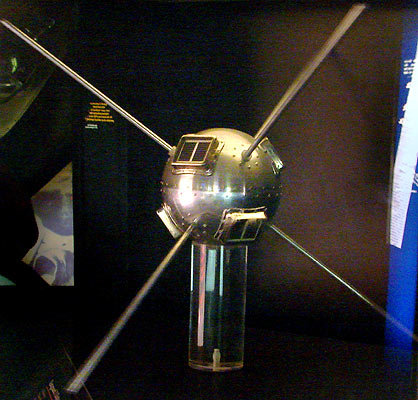
But if Vanguard did influence the design of sputnik signage, why are they called "sputniks."
And if neither Sputnik nor Vanguard influenced these commercial signs, why, I wondered, in a time of what I have always read was intense nationalism, was the name "sputnik" applied to them.
Maybe it was the catchy name combined with the wonder of the first artificial moon. Even though Russia was our nemesis, there seems to have been a sort of Sputnik mania for awhile, accompanied by an infatuation for the word itself.
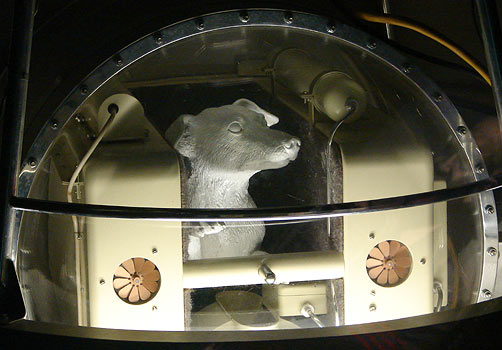
Words with the "-nik" suffix abounded for awhile. When Sputnik 2 carried the first test animal, Laika, the press nick-named the ill-fated dog "Muttnik." This is another Cosmosphere exhibit, utilizing an engineering test unit built by the same Russian company that built Sputnik 2.
When the first U.S. Vanguard satellite failed, the world press coined "Flopnik", Kaputnik", "Stayputnik" and "Puffnik".

And man-oh-man, daddy-o, the word "Beatnik" was inspired by Sputnik. San Francisco journalist Herb Caen coined it in April 2, 1958 newspaper column.
Heck, my mom tells me that my brother, born in May of 1957, was nicknamed "Sputnik" by an uncle.
None of this was telling me if sputniks were influenced by the early satellite programs, so it was time to reach out.
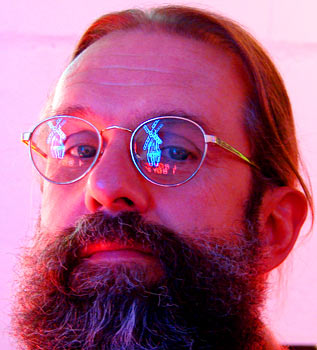
We are fortunate indeed to live in these days of the Internet. I emailed a man I'd met a few months ago, Tod Swormstedt of Cincinnati's American Sign Museum and asked what he knew about this. His response was something I should have thought of in the first place.
Tod referred me to fellow webmaster, canine agility trial enthusiast and roadside architecture maven Debra Jane Seltzer who happened to share my curiosity about sputniks. She is also one of my fellow commentators in Roadside Attractions.
"I have been obsessed with Roto-Spheres since about 2001 when I saw the first one in Mankato, MN", Debra Jane wrote. She has a Roto-Sphere page on her website and has written an article connected to the subject for the Society for Commercial Archeology.
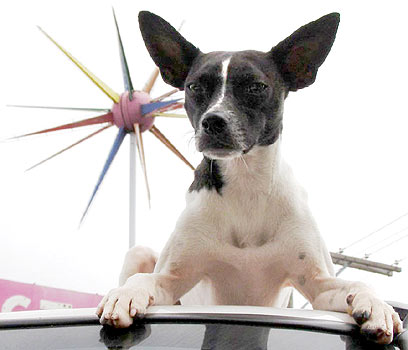
She even named one of her dogs "Sputnik" after her obsession with the signs and the dog's own "manic obsession with ballies" and a pair of ears that are...well, just look and see. Also the name "Sputnik" means "fellow traveler" in Russian, so it just fit. (photo by Debra Jane Seltzer)
Acting on a tip from Tod, Debra Jane had already tracked down the inventor of the Roto-Sphere who is now in his 80's and retired.
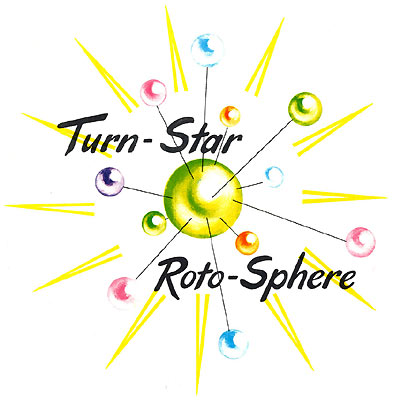
Warren Milks made about 230 Roto-Spheres from 1960-1969 in his Bossier, Louisiana, sign shop. Milks gave Debra Jane a brochure which can be seen in its entirety at her Flickr page. Only 15 or so Roto-Spheres remain, and far fewer than that are in full working order.
It is important to note that the 1960 date for the first Roto-Sphere makes it the oldest "sputnik" type of sign I know of. My interviews with business owners and jaunts through old newspaper articles and advertisements place all of the others I've seen as not quite that old. That's not to say there aren't any older than the first Roto-Sphere; but I can't document any that are.
Debra Jane reports: "Milks says he wasn't inspired by the space age or Sputniks at all. [He has] a vague recollection of...watching a TV commercial that included a little spinning object like a Xmas tree ornament that was spinning slowly and it got him to thinking about how he could create a sign like that. No recall of what the commercial was for, the brand, the TV show, nothing."
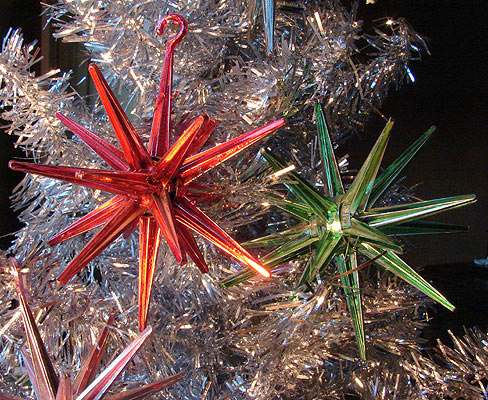
I bought some "vintage sputnik ornaments" on eBay for this photo - there almost always are some - after I'd sent some eBay links to Debra Jane who forwarded them to Milks. He indicated a recognition of this particular type. I don't know when these were made; if any of you readers do, please comment. (Now I'm all ready for Sputmas, with my Sputmas tree...anyone know any Sputmas carols?...maybe an adaptation of Donald Fagen.)
So, my first question, as to whether sputnik balls were Sputnik-inspired, is as answered as it's going to be, as least as far as Roto-Spheres are concerned. Milks says he was not inspired by Sputnik or the space age, though one could argue that it would be impossible to avoid being subconsciously inspired by Sputnik and Vanguard media imagery in 1957-1960.
What else could have inspired him, or any other sign maker, for that matter?
I was also able to question Alan Hess, author of one of my favorite wishbooks, Googie Redux: Ultramodern Roadside Architecture , as to the origins of the sputnik.
, as to the origins of the sputnik.
"I...kind of suspect that the form was in use before 1957. The starburst was used in two dimensions as a decorative element on dingbat apartments in LA and elsewhere before that....I suspect the sputnik form is a three dimensional evolution of the form in some way. A similar 2D shape was used by various Modern artists (Miro, Calder) before Sputnik, so it was in the air. And of course the typesetter's name for that form was dingbat.."
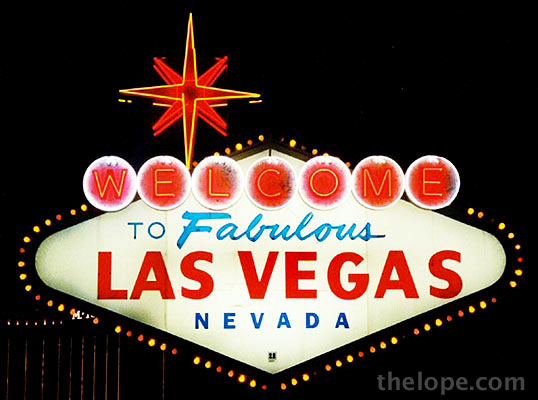
Hess mentions starbursts, which of course have been drawn by mankind for centuries, but mentions them in the context of what a sign maker might have been paying attention to. A prominent starburst - then and now - would be the 1959 Welcome to Las Vegas sign, which pre-dates the first Roto-Sphere by one year. This photo is from 2005. I've shot quite a few signs with similar starbursts, but no others with good, definite documentation as to age.
A dingbat apartment is a sort of boxy apartment building on stilts, with parking underneath. They were popular in Los Angeles for a time, and were often dressed up on the outside with decorative type styles and the very forms Hess describes, apparently before Sputnik and definitely before the Roto-Sphere. I haven't seen many of these myself, and have no pictures of them.
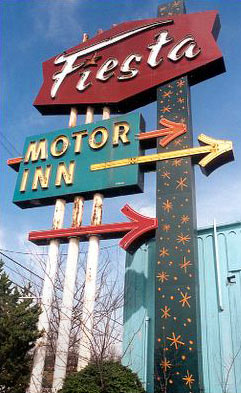
I have, however photographed signage which uses dingbat shapes, such as this one for the Fiesta Motor Inn in Arlington, Texas, which I shot in 2002. I've tried repeatedly by phone to find the age of this place, with no success. They usually hang up when I ask the question. As I recall, it wasn't the sort of place I felt safe hanging around to do pictures, but now I'm glad I did (Thanks to Deborah for furnishing the fast get-away.)
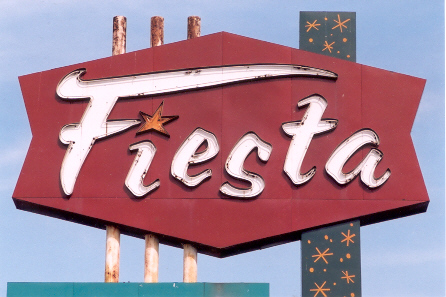
A close-up. Note the "i" in Fiesta is a star.
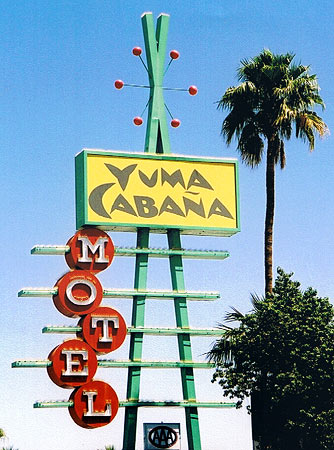
The Yuma Cabana Motel in Yuma, Arizona, is much friendlier and I'd love to stay there sometime. It was built in the early to mid 1960s. Note the asterisk-like dingbat at the top of the sign. This is the sign as of 2004; as far as I know, it still looks the same.
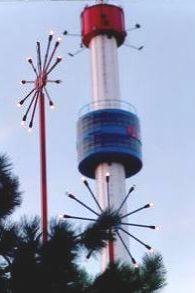
Here are some starburst or dingbat-like...well, thingies, at the Oklahoma State Fairgrounds in Oklahoma City. I think I shot this in about 1999. There were also similar forms in the now-demolished Bell's Amusement park in Tulsa, Oklahoma. I used to call them "electric asterisks on a stick". My best information is that these decorations were inspired by the 1964-65 New York World's Fair, so they are definitely post-sputnik and didn't influence the Roto-Sphere.
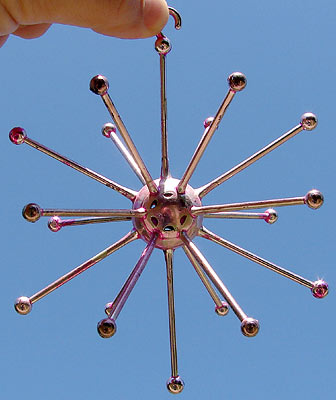
I bought this three dimensional dingbat-like ornament over ten years ago at Creatures of Habit in Paducah, Kentucky, a store that carries a lot of atomic-era antiques. Neither I nor the proprietors know its age.
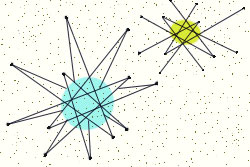
This Starburst pattern decorated a line of Franciscan pottery from 1954 to 1957, before either Sputnik or the Roto-Sphere. It was a good seller during those years, and would have been common in the late 1950s.
Hess mentioned the Spanish painter Joan Miro. His 1941 work Constellations amoreaux d'une Femme, shows his use of four intersecting lines to form eight-pointed stars, a motif he repeated often. It's worth noting that Miro prints were selling very well in the late 1950s.
I found fewer starburst forms in Alexander Calder's works, at least those which I could access, but here is his 1955 work Mollusks at the Calder Foundation website.
As to my other question, about whether spiky spheres were called "sputniks" back in the Sputnik era, Hess quite handily responded:
"...the other question is if the 3D shape of a ball with spiky lines coming out of it was called a sputnik popularly and generally in the 1950s-60s...and I can testify first hand that it was. I was in kindergarten in 1957 and the idea of space exploration and Sputnik was electrifying even in that grade. I distinctly remember drawing that form of a circle with lines radiating out from it in all directions (not actually what Sputnik looked like, but that was the popular image of it) over and over (it was easy to draw), and we kids called it a sputnik. The Vanguard name was not nearly so widely known." (Thanks to Brian Butko for putting me in touch with Alan Hess.)
In addition, the Roto-Sphere catalog Debra Jane scanned contains the following text: "In this day and age of space ships, flying saucers and "sputniks", a new series of developments have come to the electrical sign and display industry." and "The daylight effect of all Roto-Sphere units is like a tumbling sputnik."
Well, that could not have been more easy - an eye-witness to 1957 confirming that the shape that would become the Roto-Sphere, et al, was called "sputnik" and inspired by Sputnik, even though it doesn't look like the satellite. And, printed period references to the Roto-Sphere as a "sputnik" by its very manufacturer make that a question answered with finality.
A Gallery of Sputniks
Roto-Spheres are the mother ships of all sputnik balls, so that's where I'll start.
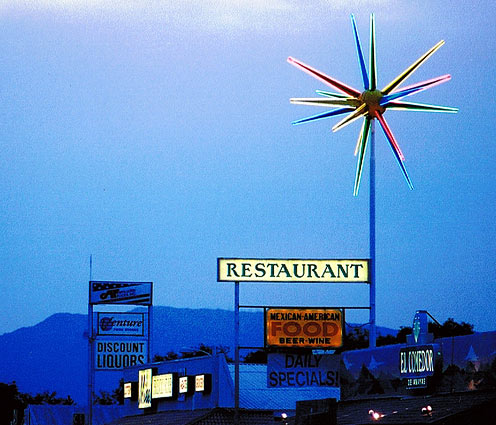
The Roto-Sphere of the El Comedor de Anayas Restaurant dominates the sky in Moriarty, New Mexico, like a UFO that got lost on the way to Roswell. The restaurant is right along Route 66 and the Roto-Sphere is visible from I-40.
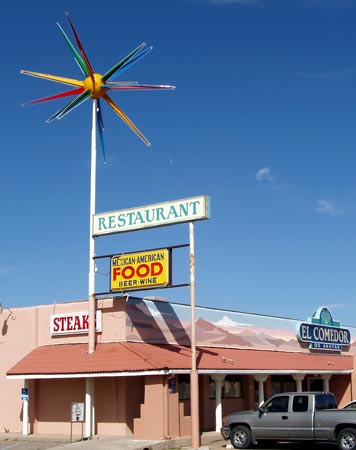
The Roto-Sphere was an add-on, purchased in the 1960's. The Restaurant itself has been in the Anayas family for 54 years.
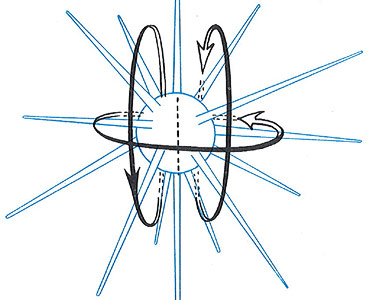
And now for the "Roto" part. Above is a diagram from the catalog Milks gave Debra Jane. Below is a short digital video clip I made from an analog video I shot in 2003. As to measurements, those sixteen aluminum, neon-outlined spikes are each eight feet long. The center ball is composed of two counter-rotating hemispheres that make a 37" sphere of 1/2" steel. The whole thing weighs 1,000 pounds and rotates on the pole. The mechanism that drives it resembles an automobile's rear axle differential, making it problematic and costly to maintain. The result is hypnotic, though, as you'll see.
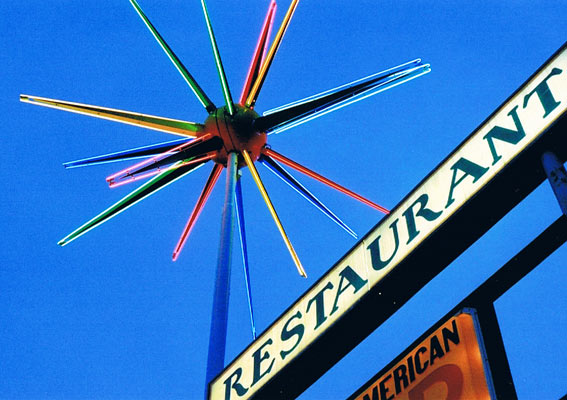
This particular Roto-Sphere was refurbished in 2003, courtesy of a joint project of the New Mexico Route 66 Association, the New Mexico Historic Preservation Division, and the National Park Service Route 66 Corridor Preservation Office. For a very detailed breakdown of the project, check out this page at the National Park Service website. Here's a summery of the result on the New Mexico Route 66 Association website:
"Over at the El Comedor restaurant in Moriarty is where the project got wild and crazy with the restoration of Rube Goldberg type device called a rotosphere. When folks first encounter the rotosphere, it is hard not to say, “What in tarnation is that?” The rotosphere consists of two vertically counter-rotating spiked hemispheres with the entire unit rotating horizontally above a pole. The drive mechanism is an electric motor driven Ford Model A differential. The rotosphere was overhauled and refurbished by Soutwest Outdoor Electric of Albuquerque. The 8-foot long rainbow-colored spikes are individually outlined in neon by A Brighter Image Neon of Albuquerque. To see it in person is to witness an 18 foot diameter kaleidoscopic UFO. The El Comedor rotosphere is believed to be the only operational rotosphere along the length of Route 66. Bring a lawn chair and enjoy but be careful, you may get mesmerized."
"Mesmerized" is right. Here's another video clip. The colors in these clips do not do justice to the real thing.
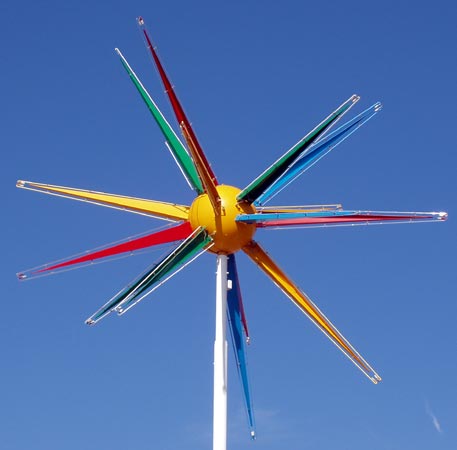
Although it is one of the most consistently operational Roto-Spheres still in existence, Manager Michaela Allen told me earlier this week that it broke down in 2006 and won't be fixed until, she speculated with a laugh, next summer. It still lights up, she says; it just doesn't move at the moment. By the way, I ate at the El Comedor, and it was good. Mexican food is not my favorite cuisine, but hey, they've got a neon sputnik to bask under.
She says the breakdown was not weather-related and that the sign has lost no neon, as I'd feared it might when I passed through in March of this year, right on the heels of the hail storm that had trashed so much neon in other New Mexico cities (notably, Tucumcari).
Whether the Moriarty Roto-Sphere moves or not, the next time I'm at the El Comedor, I'm dining in a chaise lounge in the parking lot, wearing sunglasses at night. And doesn't "Moriarty Roto-Sphere" sound like a cool Victorian weapon cooked up by Sherlock Holmes' nemesis?
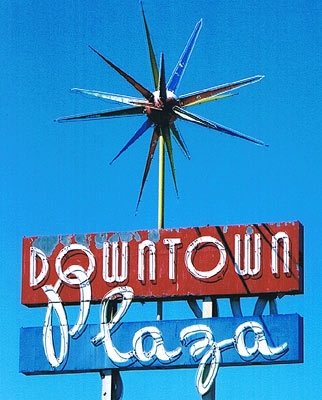
Although I believe the El Comedor Roto-Sphere to be the only one on Route 66, this one in Gallup, New Mexico is very close - when it's at home. When I photographed it in 2004, it neither lit up nor was it moving.
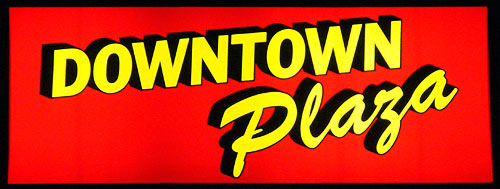
I had read in Route 66 News that this Roto-Sphere was removed for renovation in March of 2006 and hoped it would have been returned by March 2007 when I was last through Gallup, but instead I found this mediocre back lit plastic sign in its place. Do not get me started about back lit plastic. However, Debra Jane Seltzer tells me that she checked on the Roto-Sphere and found that work had finally begun on it in the past few weeks.
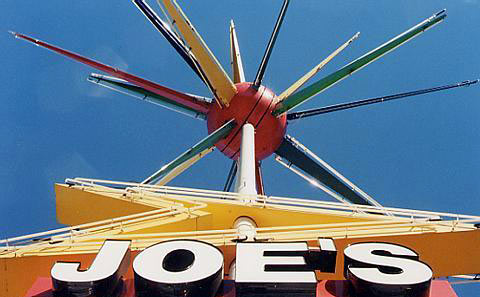
The first Roto-Sphere I photographed was this one at Joe's Liquor and Spirits in Memphis, Tennessee, in 2001. It wasn't working when I was there in September of 2001, and the manager told me it had already been refurbished in 1999, but was a complex enough mechanism to require replacement motors and neon tubes occasionally.
Debra Jane gives details about Joe's on her Roto-Sphere page:
"Joe's Liquor Store opened in 1962. A newspaper advertisement announcing the store's Grand Opening featured a photo of its Roto-Sphere with the caption "At the Sign of the Sputnik". By the mid-1970s, their sign had fallen into serious disrepair.
In 1999, Joe's Liquor Store's new owners decided to have their sign restored. They were able to raise the full $12,000 needed through a fundraising event. This "Sputnik Relaunch Party" drew about 450 people from the community and featured live bands, a silent auction, and a fireworks display. The restoration took three months. Since then, Sputnik's motor has been replaced three or four times and it is now completely electric. Although the neon is extra-strength, about two tubes break each year and require replacement."
I phoned Joe's a few days ago and the manager told me that the sign is currently rotating, but with a couple neon tubes not working at the moment.
Here's a video of the rotosphere at Joe's Liquor shot in the summer of 2009 and sent to us by film-maker Steve Holmes. Beware, the sound is loud:
And a little pop-culture note on Joe's: According to Roadside Peek, "Cybil Shepherd referenced it in her autobiography, Cybil Disobedience."
After the success of Milk's Roto-Sphere, he attempted to market several variations, which may be seen in the catalog on Debra Jane's Flickr page. You really want to see the whole catalog, believe me, but here are three tasty excerpts.
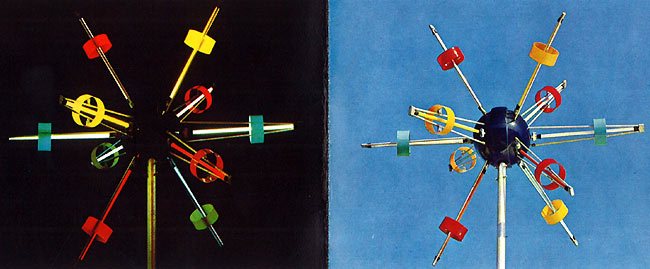
Milks marketed the Turn-Star as a smaller, lighter and less-expensive alternative to the Roto-Sphere. It had a two-foot diameter sphere with colored flourescent tubes in the arms. A full-size Roto-Sphere weighed 1,000 pounds, according to the catalog. It does not report the weight of the Turn-Star.
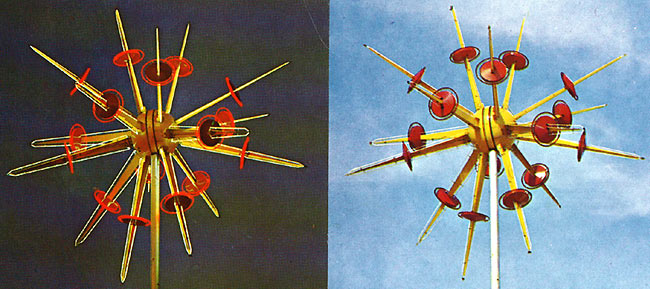
The Roto-Ring was a full-size enhancement of the original Roto-Sphere. It used disks with neon rings.
I have heard no accounts of surviving Turn-Stars or Roto-Rings. If any of you know of one, please comment.
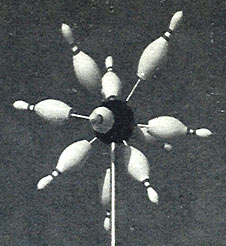
The Roto-Sphere bowling pin unit may have been a one-time production for Holiday Lanes in Bossier City, Louisianna. The 15' diameter, 1,100 lb. unit used translucent interior-illuminted bowling pins. Best information is that it no longer exists.
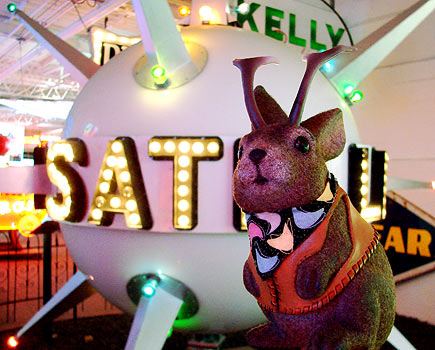
Ace recently visited this next sputnik at the place of its frustratingly early retirement. The Satellite Shopland sputnik now lives safely at Cincinnati's American Sign Museum, watched over by curator Tod Swormstedt.
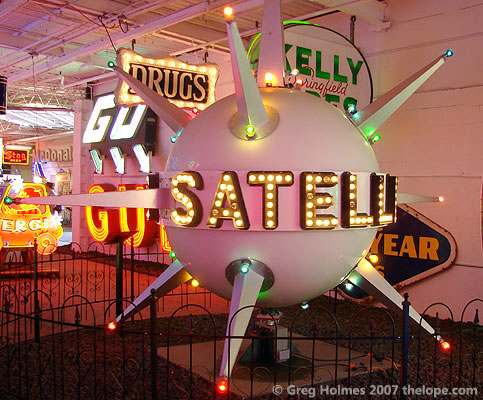
Tod was most helpful in filling me in on its history:
"I have documentation from the son of the shopping center's first anchor tenants—Roland and Helen Jensen—who says the market opened in July 1963. Dan Jensen, who told me this, operated the store from July 1978 until he sold it in 1997.
The landlord — Clarence Meddock — actually built the sign in his garage in Downey, CA. He tried to get a sign company to build the sign to his specs, but no one would do it. The sign came down in 1994 as part of Disneyland's "beautification" campaign."
The "beautification" campaign Tod speaks of is of great irritation to those of us who believe that mid-20th century googie signage is part of our history and our heritage, every bit as much as the Victorian houses that would illicit more of an uproar, were they to be threatened.
See how the shop owners got in a jab at Disney by featuring an image of the old sign on the new "approved" one.
Here's a short video clip I shot at the museum in July of this year.
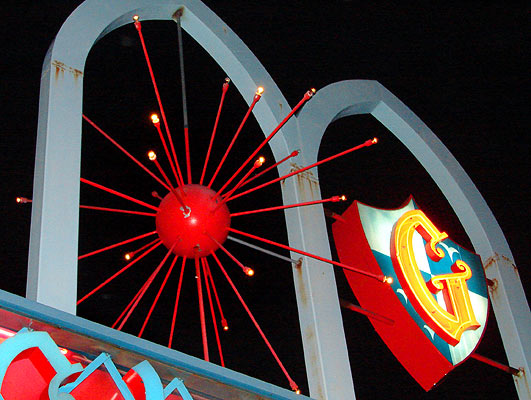
Another re-located sputnik graces the parking lot of the Metcalf South Mall in Overland Park, Kansas. This fine example is part of a 1966 vintage sign for the Glenwood Theatre. It was moved a few years ago to this location, and advertises the art theater for which the sign was moved.
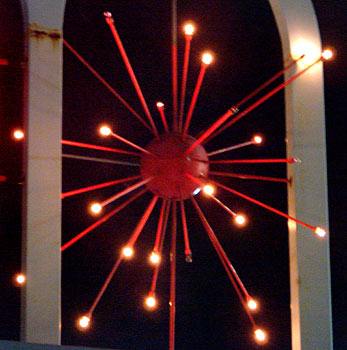
The Sputnik part of the sign contains two circuits which cause the light bulbs on the ends of the spikes to slowly alternate. From a distance, this gives a twinkle effect.
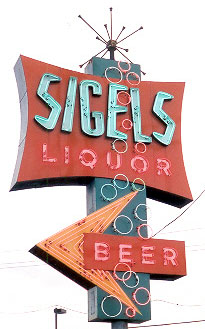
I ran across this sputnik at Sigels Liquor Store # 7 at 5636 Lemmon Avenue in Dallas, Texas. I spoke with the manager and even the national office as to the date. They were most friendly, but could not tell me the date of the sign. The sputnik part of the sign resembles interior sputnik ceiling fixtures that sell on eBay for big bucks.
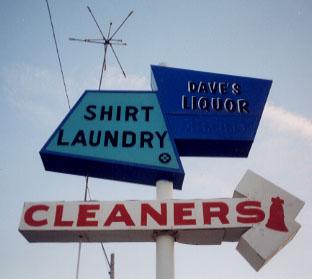
I shot Dave's Liquor on a trip through Louisiana and Arkansas in 2001. Its sputnik looks a bit mangled.
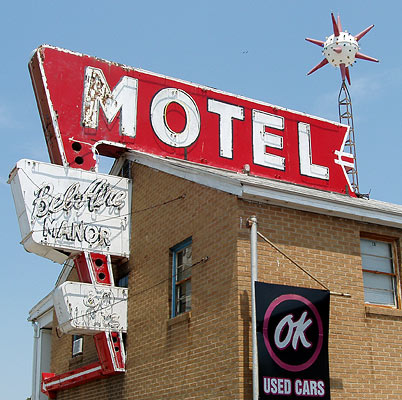
One challenge in tracking down the age of sputniks is that were often sold as add-ons to existing signs, and they were sometimes scavenged from older businesses, so the age of the business or even the rest of the sign is only a partial indicator of their age. Note that the sputnik on the Bel Aire in Springfield, IL, is not part of the rest of the sign structure. I shot it in June of 2006 and checked on it by phone a few days ago; it's still there. The manager did not know its age, but said it does light up. It doesn't rotate, and never did, according to him. As a matter of fact, I've never seen one of this type of sputnik that does.
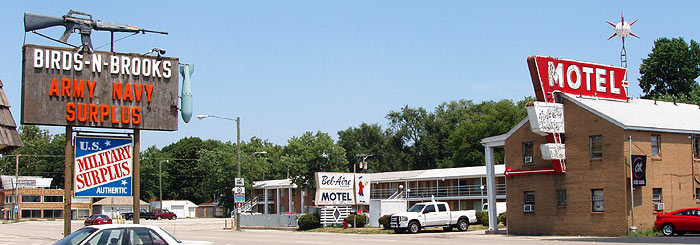
A wider view shows a gun pointed at it from an army surplus store across Route 66. Kinda funny, huh? - an American gun pointed at something nick-named for a Russian satellite.
I asked Tod Swormstedt if he knew when these fiberglass sputniks were made and he said he did not, but confirmed they were certainly a production item, meaning mass-produced on some scale, probably as an add-on.
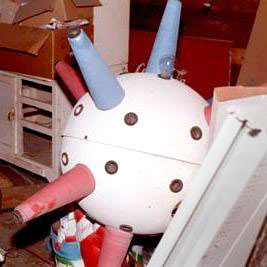
I own this smaller example; I bought it a few years ago after a wind storm blew it off a pole outside a Mexican restaurant in Wichita. It was broken and left for scrap in back of the building. An electronic mechanism inside is marked "MODEL 22 C2" and "A. B. McMAHAN ST. PAUL MINN", though I don't know if this applies to the entire sputnik or just that one component. If anyone else knows, please comment.
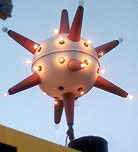
Here's another one I saw in Texas, back about 2002. It looks to be the same as the one I got in Wichita, though the spikes are of different colors. The lights on it were working, and alternated between the bulbs on the sphere and those on the spikes, creating the impression of an explosion, especially at night when the sphere and spikes could not be seen well. You know, these look as much inspired by WWII aquatic mines as much as by Sputnik.
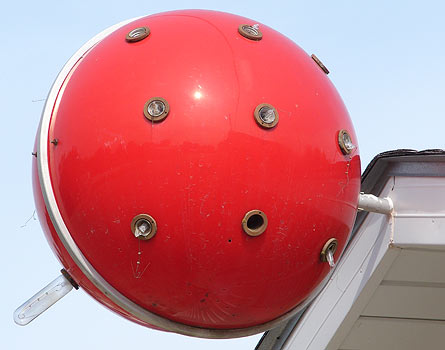
And here is what I would presume to be a sort of budget sputnik. I've seen these orange plastic balls a few times, almost always in the same condition as this one - pretty much neglected with one or two intact light bulb "spikes." This one is in rural Kansas.
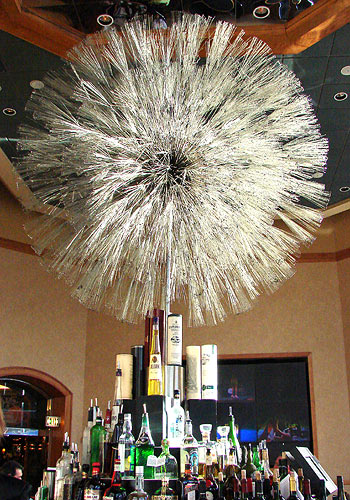
On any given day, EBay is full of "sputnik" interior ceiling fixtures of various ages. By far, the most elaborate sputnik or starburst ceiling fixture I've ever seen is this one at the Adams Mark Hotel on 16th Street in Denver.
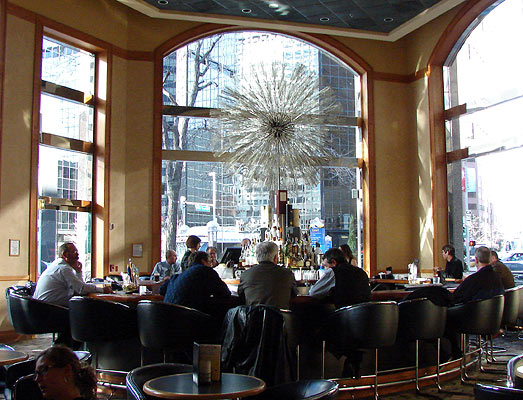
This particular hotel backs onto Denver's bit of the Lincoln Highway, for those of you who like to combine interests.
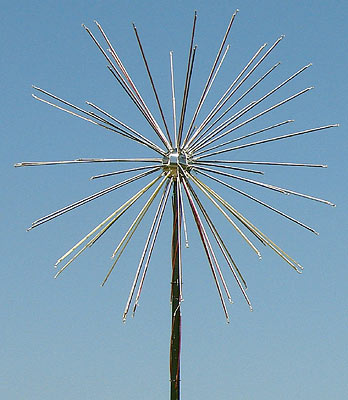
There are newer outdoor spiky balls out there. These tend to have rope light or fibre-optic spikes and are commonly seen outside night clubs, large fireworks warehouses and pornography vendors. I first noticed these in the late 1980s and they don't seem too durable. In Kansas, they tend to linger with the spikes of the top hemisphere blown over or missing, leaving a sort of bald sputnik. And to what business does this partiular one draw attention?
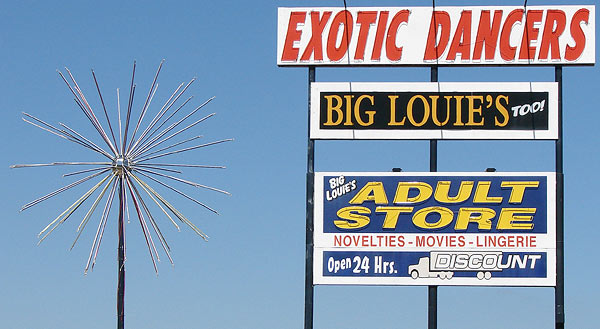
Big Louie's on Route 66 in St Robert, Missouri, near Fort Leonard Wood. Big Louie is certainly the most colorful example of vendors along Missouri's Route 66/I-44 porn corridor.
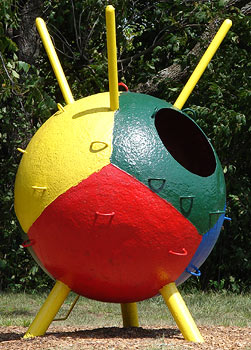
And to switch gears completely, and in more than one way, here's a piece of playground equipment at a day care center near Blue Springs, Missouri. C'est sputnik, or no?
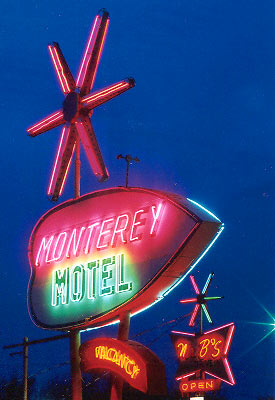
It's not a sputnik, but it's cool. The afore-mentioned Monterey Motel in Choteau, OK and Mr B's restaurant across highway 69 use what Debra Jane identifies as the C-152-Lectra produced by the Standard Neon Supply Company of St. Louis in the early 1960s.
Postscript
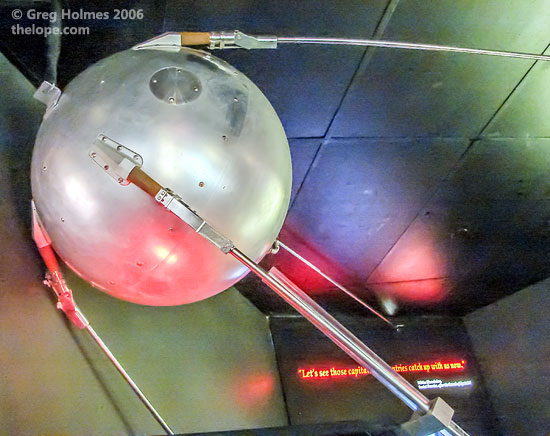
What happened to Sputnik 1? Well, most experts think all parts associated with it - the satellite as well as the booster rocket that got it into orbit - burned up in the atmosphere a few month after launch. Not so, says Bob Morgan, whose father told him that he recovered some red-hot parts from his land on the morning of December 4, 1957. Morgan inherited those parts and they were recently put on display by the Beat Museum in San Francisco. Read about it in the New York Times (free registration may be required).
Very cool, full-circle closure, if true - that parts associated with Sputnik, the satellite that inspired the name "Beatnik" should end up in the Beat Museum, dedicated to the legacy of the Beatniks.
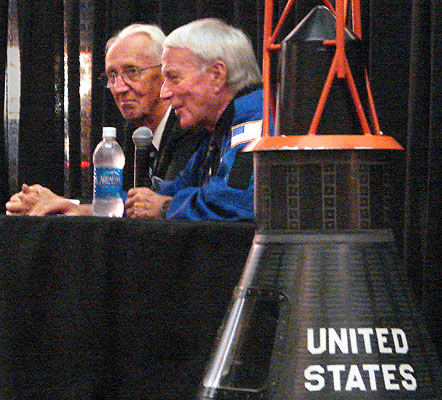
During the preparation of this post, I had the opportunity to meet and briefly speak with two of American manned space flight's historic figures.
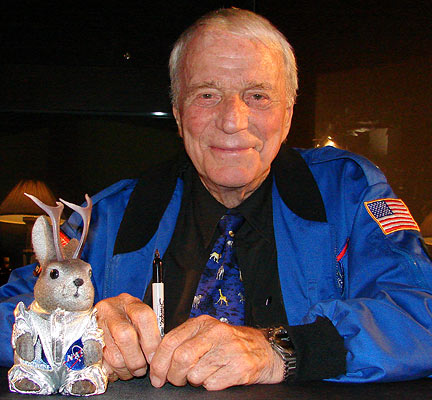
I asked Scott Carpenter, one of the "original 7" Mercury astronauts, if the astronauts were aware at the time of the impact the space program was having on American architecture and language. He replied that they were "above all of that" and "It didn't have anything to do with what we were doing."
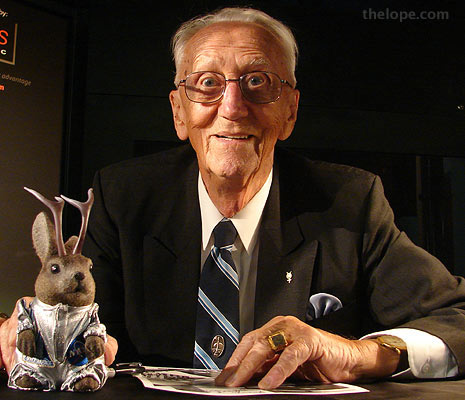
I also had the chance to speak with Guenter F. Wendt, the legendary Pad Leader during the early parts of the manned space program. He is part of that generation of ex-German WWII vets who later immigrated to the U.S. and helped us get the rockets off the ground. As Pad Leader, he was also the last person the astronauts would see before they took off.
He responded to the same question with "We didn't have time to think about it, you know...we had more or less a one-track mind"
He added that, pertaining to the Russian launch of Sputnik:
"we could have launched a satellite before that...but it was agreed the Navy would launch one with that stupid rocket."
I'm no expert on the early satellite program, but I think he is referring to President Eisenhower's decision to forgo using the Army's Jupiter-C rocket, which was already capable of sending up a satellite in 1955, in favor of developing a new, non-military rocket for political reasons. The two years it took to develop the new rocket, the Navy's Vanguard, gave the Russians enough time to develop and launch Sputnik. Eventually, the first successful U.S. satellite was the Army and Jet Propulsion Laboratory's Explorer, launched on January 31, 1958, with the Jupiter-C rocket that could have been used two years earlier.
Wendt is a human time capsule of period stories - especially funny ones - including a tale about a NASA chimpanzee flinging dung at a politician. You just can't beat a good dung-flinging chimp story, can you? I'd come to see Carpenter, but left happy to have met Wendt.
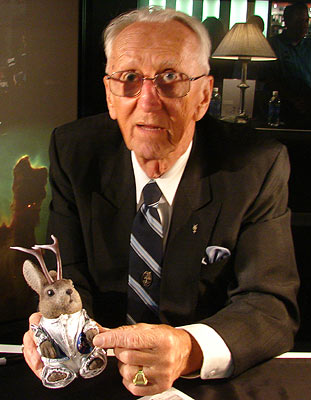
"Do you know what NASA stands for?" Wendt asked while pointing to Ace and noting his NASA patch.
Like a grade school kid who wanted to show off the right answer, I replied "National Aeronautics and Space Administration?"
His answer reminded me of my quest for the ages and inspirations of sputniks.
He smiled and quipped:
"Never Absolutely Sure of Anything."
December 17 addendum:
Saturday, December 8, I was able to question Dr. Michael J Neufeld, Chairman of the Space History Division of the National Air and Space Museum. Neufeld was lecturing at Kansas Cosmosphere and Space center about his book Von Braun: Dreamer of Space, Engineer of War .
.
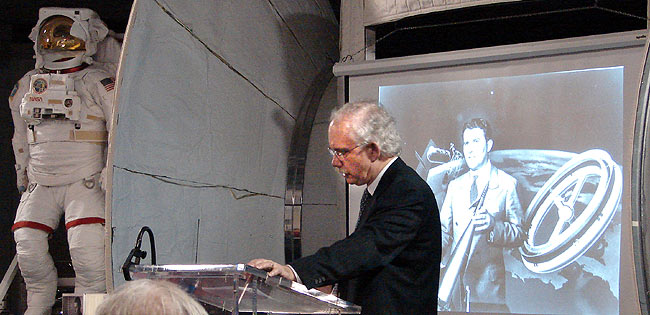
I asked Dr Neufeld why, in a time of what I would assume to be intense Nationalism, that spiky ball shapes like Rotospheres were called "Sputnik", which they didn't resemble, instead of Vanguard, which they did.
He replied that Sputnik was "just such a defining event" and told me that, at first, we didn't have any pictures of the Russian satellite.
"Vanguard iconography was planted in the American psyche before Sputnik" he said.
Well, there you are.
If I understand the sequence correctly, Americans see images of the spiked ball called Vanguard, then hear that the Russians have launched a satellite. They go ga-ga over this, and kids like Alan Hess draw the "form of a circle with lines radiating out from it in all directions" on their Big Chief drawing tablets and call it "Sputnik."
Isn't research fun?
Now, to prepare my Sputmas tree.

Impressive; isn't it? And it moves too, as I'll show you later. Its builder called it a Roto-Sphere, but it and its spiky signage relatives are more commonly known as "sputniks." This one graces the El Comedor de Anayas Restaurant in Moriarty, New Mexico.
I fell under the whirling neon spell of these things 29 years ago after travelling to a Yes concert in Tulsa, Oklahoma. Granted, I was the impressionable age of 16 and the smoke drifting about the auditorium might have made things seem a bit more cosmic afterwards. It had disappeared from the Tulsa skyline by the early 1980s, but that spinning UFO-like wonder sure left an impression on me.

In recent years, while photographing roadside architecture, I would see the general form of the spiked ball repeated every so often, and much of the time locals would refer to the sign as a sputnik, as with this sign on the Bel-Aire motel in Springfield, Illinois on Route 66.

I would often see two-dimensional signs like this one, at the Monterey Motel in Choteau, Oklahoma, and wonder if they pre-dated the sputnik signs or if they were a less-expensive alternative that came after. Most such businesses have been through more than one owner, and obtaining precise age information is problematic.
With the 50th anniversary of the launch of the real Sputnik being October 4, I decided to try to find out two things:
1. Was the design of spherical and spiked roadside attention-getters really inspired by Sputnik?
2. Did the use of the label "sputnik" to describe these things originate "back in the day" (late 50's - early 60's) or was it a case of retro-naming by present-day googie and roadside aficionados.

My first step was a trip to my local space museum (What? You don't have a local space museum?), the Kansas Cosmosphere and Space Center in Hutchinson, Kansas, to refresh my memory of Sputnik.

This is an actual back-up unit, which the museum obtained from the Russian manufacturer that built the original satellite. Notice that, although it is a sphere with spikes, the resemblance to the Roto-Spheres and such ends there, as Sputnik's spikes are four trailing, almost parallel antennae.
By the way, if you're one of our younger readers and don't know about Sputnik, or you're just not up on the space program, there is a plethora of historical information about it online and elsewhere. I recommend you look at NASA's account, wikipedia's overview of the Sputnik program, wikipedia's account of Sputnik 1, Roger D. Launius' excellent framing of the politics of Sputnik and Retired Bell Laboratories and Microsoft Researcher, Don P. Mitchell's history of the planning, construction and launch of sputnik 1, with three different audio files of the signal included.
The most poetic fact - to me anyway - is that for millions of years of life on Earth, the heavens were unsullied with anything from the planet's inhabitants, and the only satellite was the moon.

Fifty years ago tonight, Sputnik changed that with a "beep-beep-beep-beep-beep" that was music to Russia and a taunting "nah-nah-nah-nah-nah" to the USA. You can hear an audio file of Sputnik's signal at the NASA website. Give it a listen and imagine the hoards of ham radio listeners hunkered in their basements in wonder and fear.
Back to the subject at hand, if Sputnik itself did not influence the forms of the spiky and spherical signs known as "sputniks", what did?

Meet Vanguard 1, one of the United States' early responses to Sputnik. According to signage at the Cosmosphere, the first Vanguard satellite was launched December 6, 1957 and did not go so well. In fact, the rocket carrying it blew up on the launch pad. Ten more Vanguard attempts were made after that, only three of which were successful. However the satellites did provide some of the first data on solar radiation and its effect on Earth's atmosphere and, unlike Sputnik, the three Vanguard satellites that made it into space are still there almost 50 years later. This particular one is a working unit built as a back-up for Vanguard I. It was scheduled to be launched on a later flight, but the program was cancelled before this happened.

But if Vanguard did influence the design of sputnik signage, why are they called "sputniks."
And if neither Sputnik nor Vanguard influenced these commercial signs, why, I wondered, in a time of what I have always read was intense nationalism, was the name "sputnik" applied to them.
Maybe it was the catchy name combined with the wonder of the first artificial moon. Even though Russia was our nemesis, there seems to have been a sort of Sputnik mania for awhile, accompanied by an infatuation for the word itself.

Words with the "-nik" suffix abounded for awhile. When Sputnik 2 carried the first test animal, Laika, the press nick-named the ill-fated dog "Muttnik." This is another Cosmosphere exhibit, utilizing an engineering test unit built by the same Russian company that built Sputnik 2.
When the first U.S. Vanguard satellite failed, the world press coined "Flopnik", Kaputnik", "Stayputnik" and "Puffnik".

And man-oh-man, daddy-o, the word "Beatnik" was inspired by Sputnik. San Francisco journalist Herb Caen coined it in April 2, 1958 newspaper column.
Heck, my mom tells me that my brother, born in May of 1957, was nicknamed "Sputnik" by an uncle.
None of this was telling me if sputniks were influenced by the early satellite programs, so it was time to reach out.

We are fortunate indeed to live in these days of the Internet. I emailed a man I'd met a few months ago, Tod Swormstedt of Cincinnati's American Sign Museum and asked what he knew about this. His response was something I should have thought of in the first place.
Tod referred me to fellow webmaster, canine agility trial enthusiast and roadside architecture maven Debra Jane Seltzer who happened to share my curiosity about sputniks. She is also one of my fellow commentators in Roadside Attractions.
"I have been obsessed with Roto-Spheres since about 2001 when I saw the first one in Mankato, MN", Debra Jane wrote. She has a Roto-Sphere page on her website and has written an article connected to the subject for the Society for Commercial Archeology.

She even named one of her dogs "Sputnik" after her obsession with the signs and the dog's own "manic obsession with ballies" and a pair of ears that are...well, just look and see. Also the name "Sputnik" means "fellow traveler" in Russian, so it just fit. (photo by Debra Jane Seltzer)
Acting on a tip from Tod, Debra Jane had already tracked down the inventor of the Roto-Sphere who is now in his 80's and retired.

Warren Milks made about 230 Roto-Spheres from 1960-1969 in his Bossier, Louisiana, sign shop. Milks gave Debra Jane a brochure which can be seen in its entirety at her Flickr page. Only 15 or so Roto-Spheres remain, and far fewer than that are in full working order.
It is important to note that the 1960 date for the first Roto-Sphere makes it the oldest "sputnik" type of sign I know of. My interviews with business owners and jaunts through old newspaper articles and advertisements place all of the others I've seen as not quite that old. That's not to say there aren't any older than the first Roto-Sphere; but I can't document any that are.
Debra Jane reports: "Milks says he wasn't inspired by the space age or Sputniks at all. [He has] a vague recollection of...watching a TV commercial that included a little spinning object like a Xmas tree ornament that was spinning slowly and it got him to thinking about how he could create a sign like that. No recall of what the commercial was for, the brand, the TV show, nothing."

I bought some "vintage sputnik ornaments" on eBay for this photo - there almost always are some - after I'd sent some eBay links to Debra Jane who forwarded them to Milks. He indicated a recognition of this particular type. I don't know when these were made; if any of you readers do, please comment. (Now I'm all ready for Sputmas, with my Sputmas tree...anyone know any Sputmas carols?...maybe an adaptation of Donald Fagen.)
So, my first question, as to whether sputnik balls were Sputnik-inspired, is as answered as it's going to be, as least as far as Roto-Spheres are concerned. Milks says he was not inspired by Sputnik or the space age, though one could argue that it would be impossible to avoid being subconsciously inspired by Sputnik and Vanguard media imagery in 1957-1960.
What else could have inspired him, or any other sign maker, for that matter?
I was also able to question Alan Hess, author of one of my favorite wishbooks, Googie Redux: Ultramodern Roadside Architecture
"I...kind of suspect that the form was in use before 1957. The starburst was used in two dimensions as a decorative element on dingbat apartments in LA and elsewhere before that....I suspect the sputnik form is a three dimensional evolution of the form in some way. A similar 2D shape was used by various Modern artists (Miro, Calder) before Sputnik, so it was in the air. And of course the typesetter's name for that form was dingbat.."

Hess mentions starbursts, which of course have been drawn by mankind for centuries, but mentions them in the context of what a sign maker might have been paying attention to. A prominent starburst - then and now - would be the 1959 Welcome to Las Vegas sign, which pre-dates the first Roto-Sphere by one year. This photo is from 2005. I've shot quite a few signs with similar starbursts, but no others with good, definite documentation as to age.
A dingbat apartment is a sort of boxy apartment building on stilts, with parking underneath. They were popular in Los Angeles for a time, and were often dressed up on the outside with decorative type styles and the very forms Hess describes, apparently before Sputnik and definitely before the Roto-Sphere. I haven't seen many of these myself, and have no pictures of them.

I have, however photographed signage which uses dingbat shapes, such as this one for the Fiesta Motor Inn in Arlington, Texas, which I shot in 2002. I've tried repeatedly by phone to find the age of this place, with no success. They usually hang up when I ask the question. As I recall, it wasn't the sort of place I felt safe hanging around to do pictures, but now I'm glad I did (Thanks to Deborah for furnishing the fast get-away.)

A close-up. Note the "i" in Fiesta is a star.

The Yuma Cabana Motel in Yuma, Arizona, is much friendlier and I'd love to stay there sometime. It was built in the early to mid 1960s. Note the asterisk-like dingbat at the top of the sign. This is the sign as of 2004; as far as I know, it still looks the same.

Here are some starburst or dingbat-like...well, thingies, at the Oklahoma State Fairgrounds in Oklahoma City. I think I shot this in about 1999. There were also similar forms in the now-demolished Bell's Amusement park in Tulsa, Oklahoma. I used to call them "electric asterisks on a stick". My best information is that these decorations were inspired by the 1964-65 New York World's Fair, so they are definitely post-sputnik and didn't influence the Roto-Sphere.

I bought this three dimensional dingbat-like ornament over ten years ago at Creatures of Habit in Paducah, Kentucky, a store that carries a lot of atomic-era antiques. Neither I nor the proprietors know its age.

This Starburst pattern decorated a line of Franciscan pottery from 1954 to 1957, before either Sputnik or the Roto-Sphere. It was a good seller during those years, and would have been common in the late 1950s.
Hess mentioned the Spanish painter Joan Miro. His 1941 work Constellations amoreaux d'une Femme, shows his use of four intersecting lines to form eight-pointed stars, a motif he repeated often. It's worth noting that Miro prints were selling very well in the late 1950s.
I found fewer starburst forms in Alexander Calder's works, at least those which I could access, but here is his 1955 work Mollusks at the Calder Foundation website.
As to my other question, about whether spiky spheres were called "sputniks" back in the Sputnik era, Hess quite handily responded:
"...the other question is if the 3D shape of a ball with spiky lines coming out of it was called a sputnik popularly and generally in the 1950s-60s...and I can testify first hand that it was. I was in kindergarten in 1957 and the idea of space exploration and Sputnik was electrifying even in that grade. I distinctly remember drawing that form of a circle with lines radiating out from it in all directions (not actually what Sputnik looked like, but that was the popular image of it) over and over (it was easy to draw), and we kids called it a sputnik. The Vanguard name was not nearly so widely known." (Thanks to Brian Butko for putting me in touch with Alan Hess.)
In addition, the Roto-Sphere catalog Debra Jane scanned contains the following text: "In this day and age of space ships, flying saucers and "sputniks", a new series of developments have come to the electrical sign and display industry." and "The daylight effect of all Roto-Sphere units is like a tumbling sputnik."
Well, that could not have been more easy - an eye-witness to 1957 confirming that the shape that would become the Roto-Sphere, et al, was called "sputnik" and inspired by Sputnik, even though it doesn't look like the satellite. And, printed period references to the Roto-Sphere as a "sputnik" by its very manufacturer make that a question answered with finality.
A Gallery of Sputniks
Roto-Spheres are the mother ships of all sputnik balls, so that's where I'll start.

The Roto-Sphere of the El Comedor de Anayas Restaurant dominates the sky in Moriarty, New Mexico, like a UFO that got lost on the way to Roswell. The restaurant is right along Route 66 and the Roto-Sphere is visible from I-40.

The Roto-Sphere was an add-on, purchased in the 1960's. The Restaurant itself has been in the Anayas family for 54 years.

And now for the "Roto" part. Above is a diagram from the catalog Milks gave Debra Jane. Below is a short digital video clip I made from an analog video I shot in 2003. As to measurements, those sixteen aluminum, neon-outlined spikes are each eight feet long. The center ball is composed of two counter-rotating hemispheres that make a 37" sphere of 1/2" steel. The whole thing weighs 1,000 pounds and rotates on the pole. The mechanism that drives it resembles an automobile's rear axle differential, making it problematic and costly to maintain. The result is hypnotic, though, as you'll see.

This particular Roto-Sphere was refurbished in 2003, courtesy of a joint project of the New Mexico Route 66 Association, the New Mexico Historic Preservation Division, and the National Park Service Route 66 Corridor Preservation Office. For a very detailed breakdown of the project, check out this page at the National Park Service website. Here's a summery of the result on the New Mexico Route 66 Association website:
"Over at the El Comedor restaurant in Moriarty is where the project got wild and crazy with the restoration of Rube Goldberg type device called a rotosphere. When folks first encounter the rotosphere, it is hard not to say, “What in tarnation is that?” The rotosphere consists of two vertically counter-rotating spiked hemispheres with the entire unit rotating horizontally above a pole. The drive mechanism is an electric motor driven Ford Model A differential. The rotosphere was overhauled and refurbished by Soutwest Outdoor Electric of Albuquerque. The 8-foot long rainbow-colored spikes are individually outlined in neon by A Brighter Image Neon of Albuquerque. To see it in person is to witness an 18 foot diameter kaleidoscopic UFO. The El Comedor rotosphere is believed to be the only operational rotosphere along the length of Route 66. Bring a lawn chair and enjoy but be careful, you may get mesmerized."
"Mesmerized" is right. Here's another video clip. The colors in these clips do not do justice to the real thing.

Although it is one of the most consistently operational Roto-Spheres still in existence, Manager Michaela Allen told me earlier this week that it broke down in 2006 and won't be fixed until, she speculated with a laugh, next summer. It still lights up, she says; it just doesn't move at the moment. By the way, I ate at the El Comedor, and it was good. Mexican food is not my favorite cuisine, but hey, they've got a neon sputnik to bask under.
She says the breakdown was not weather-related and that the sign has lost no neon, as I'd feared it might when I passed through in March of this year, right on the heels of the hail storm that had trashed so much neon in other New Mexico cities (notably, Tucumcari).
Whether the Moriarty Roto-Sphere moves or not, the next time I'm at the El Comedor, I'm dining in a chaise lounge in the parking lot, wearing sunglasses at night. And doesn't "Moriarty Roto-Sphere" sound like a cool Victorian weapon cooked up by Sherlock Holmes' nemesis?

Although I believe the El Comedor Roto-Sphere to be the only one on Route 66, this one in Gallup, New Mexico is very close - when it's at home. When I photographed it in 2004, it neither lit up nor was it moving.

I had read in Route 66 News that this Roto-Sphere was removed for renovation in March of 2006 and hoped it would have been returned by March 2007 when I was last through Gallup, but instead I found this mediocre back lit plastic sign in its place. Do not get me started about back lit plastic. However, Debra Jane Seltzer tells me that she checked on the Roto-Sphere and found that work had finally begun on it in the past few weeks.

The first Roto-Sphere I photographed was this one at Joe's Liquor and Spirits in Memphis, Tennessee, in 2001. It wasn't working when I was there in September of 2001, and the manager told me it had already been refurbished in 1999, but was a complex enough mechanism to require replacement motors and neon tubes occasionally.
Debra Jane gives details about Joe's on her Roto-Sphere page:
"Joe's Liquor Store opened in 1962. A newspaper advertisement announcing the store's Grand Opening featured a photo of its Roto-Sphere with the caption "At the Sign of the Sputnik". By the mid-1970s, their sign had fallen into serious disrepair.
In 1999, Joe's Liquor Store's new owners decided to have their sign restored. They were able to raise the full $12,000 needed through a fundraising event. This "Sputnik Relaunch Party" drew about 450 people from the community and featured live bands, a silent auction, and a fireworks display. The restoration took three months. Since then, Sputnik's motor has been replaced three or four times and it is now completely electric. Although the neon is extra-strength, about two tubes break each year and require replacement."
I phoned Joe's a few days ago and the manager told me that the sign is currently rotating, but with a couple neon tubes not working at the moment.
Here's a video of the rotosphere at Joe's Liquor shot in the summer of 2009 and sent to us by film-maker Steve Holmes. Beware, the sound is loud:
And a little pop-culture note on Joe's: According to Roadside Peek, "Cybil Shepherd referenced it in her autobiography, Cybil Disobedience."
After the success of Milk's Roto-Sphere, he attempted to market several variations, which may be seen in the catalog on Debra Jane's Flickr page. You really want to see the whole catalog, believe me, but here are three tasty excerpts.

Milks marketed the Turn-Star as a smaller, lighter and less-expensive alternative to the Roto-Sphere. It had a two-foot diameter sphere with colored flourescent tubes in the arms. A full-size Roto-Sphere weighed 1,000 pounds, according to the catalog. It does not report the weight of the Turn-Star.

The Roto-Ring was a full-size enhancement of the original Roto-Sphere. It used disks with neon rings.
I have heard no accounts of surviving Turn-Stars or Roto-Rings. If any of you know of one, please comment.

The Roto-Sphere bowling pin unit may have been a one-time production for Holiday Lanes in Bossier City, Louisianna. The 15' diameter, 1,100 lb. unit used translucent interior-illuminted bowling pins. Best information is that it no longer exists.

Ace recently visited this next sputnik at the place of its frustratingly early retirement. The Satellite Shopland sputnik now lives safely at Cincinnati's American Sign Museum, watched over by curator Tod Swormstedt.

Tod was most helpful in filling me in on its history:
"I have documentation from the son of the shopping center's first anchor tenants—Roland and Helen Jensen—who says the market opened in July 1963. Dan Jensen, who told me this, operated the store from July 1978 until he sold it in 1997.
The landlord — Clarence Meddock — actually built the sign in his garage in Downey, CA. He tried to get a sign company to build the sign to his specs, but no one would do it. The sign came down in 1994 as part of Disneyland's "beautification" campaign."
The "beautification" campaign Tod speaks of is of great irritation to those of us who believe that mid-20th century googie signage is part of our history and our heritage, every bit as much as the Victorian houses that would illicit more of an uproar, were they to be threatened.
See how the shop owners got in a jab at Disney by featuring an image of the old sign on the new "approved" one.
Here's a short video clip I shot at the museum in July of this year.

Another re-located sputnik graces the parking lot of the Metcalf South Mall in Overland Park, Kansas. This fine example is part of a 1966 vintage sign for the Glenwood Theatre. It was moved a few years ago to this location, and advertises the art theater for which the sign was moved.

The Sputnik part of the sign contains two circuits which cause the light bulbs on the ends of the spikes to slowly alternate. From a distance, this gives a twinkle effect.

I ran across this sputnik at Sigels Liquor Store # 7 at 5636 Lemmon Avenue in Dallas, Texas. I spoke with the manager and even the national office as to the date. They were most friendly, but could not tell me the date of the sign. The sputnik part of the sign resembles interior sputnik ceiling fixtures that sell on eBay for big bucks.

I shot Dave's Liquor on a trip through Louisiana and Arkansas in 2001. Its sputnik looks a bit mangled.

One challenge in tracking down the age of sputniks is that were often sold as add-ons to existing signs, and they were sometimes scavenged from older businesses, so the age of the business or even the rest of the sign is only a partial indicator of their age. Note that the sputnik on the Bel Aire in Springfield, IL, is not part of the rest of the sign structure. I shot it in June of 2006 and checked on it by phone a few days ago; it's still there. The manager did not know its age, but said it does light up. It doesn't rotate, and never did, according to him. As a matter of fact, I've never seen one of this type of sputnik that does.

A wider view shows a gun pointed at it from an army surplus store across Route 66. Kinda funny, huh? - an American gun pointed at something nick-named for a Russian satellite.
I asked Tod Swormstedt if he knew when these fiberglass sputniks were made and he said he did not, but confirmed they were certainly a production item, meaning mass-produced on some scale, probably as an add-on.

I own this smaller example; I bought it a few years ago after a wind storm blew it off a pole outside a Mexican restaurant in Wichita. It was broken and left for scrap in back of the building. An electronic mechanism inside is marked "MODEL 22 C2" and "A. B. McMAHAN ST. PAUL MINN", though I don't know if this applies to the entire sputnik or just that one component. If anyone else knows, please comment.

Here's another one I saw in Texas, back about 2002. It looks to be the same as the one I got in Wichita, though the spikes are of different colors. The lights on it were working, and alternated between the bulbs on the sphere and those on the spikes, creating the impression of an explosion, especially at night when the sphere and spikes could not be seen well. You know, these look as much inspired by WWII aquatic mines as much as by Sputnik.

And here is what I would presume to be a sort of budget sputnik. I've seen these orange plastic balls a few times, almost always in the same condition as this one - pretty much neglected with one or two intact light bulb "spikes." This one is in rural Kansas.

On any given day, EBay is full of "sputnik" interior ceiling fixtures of various ages. By far, the most elaborate sputnik or starburst ceiling fixture I've ever seen is this one at the Adams Mark Hotel on 16th Street in Denver.

This particular hotel backs onto Denver's bit of the Lincoln Highway, for those of you who like to combine interests.

There are newer outdoor spiky balls out there. These tend to have rope light or fibre-optic spikes and are commonly seen outside night clubs, large fireworks warehouses and pornography vendors. I first noticed these in the late 1980s and they don't seem too durable. In Kansas, they tend to linger with the spikes of the top hemisphere blown over or missing, leaving a sort of bald sputnik. And to what business does this partiular one draw attention?

Big Louie's on Route 66 in St Robert, Missouri, near Fort Leonard Wood. Big Louie is certainly the most colorful example of vendors along Missouri's Route 66/I-44 porn corridor.

And to switch gears completely, and in more than one way, here's a piece of playground equipment at a day care center near Blue Springs, Missouri. C'est sputnik, or no?

It's not a sputnik, but it's cool. The afore-mentioned Monterey Motel in Choteau, OK and Mr B's restaurant across highway 69 use what Debra Jane identifies as the C-152-Lectra produced by the Standard Neon Supply Company of St. Louis in the early 1960s.
Postscript

What happened to Sputnik 1? Well, most experts think all parts associated with it - the satellite as well as the booster rocket that got it into orbit - burned up in the atmosphere a few month after launch. Not so, says Bob Morgan, whose father told him that he recovered some red-hot parts from his land on the morning of December 4, 1957. Morgan inherited those parts and they were recently put on display by the Beat Museum in San Francisco. Read about it in the New York Times (free registration may be required).
Very cool, full-circle closure, if true - that parts associated with Sputnik, the satellite that inspired the name "Beatnik" should end up in the Beat Museum, dedicated to the legacy of the Beatniks.

During the preparation of this post, I had the opportunity to meet and briefly speak with two of American manned space flight's historic figures.

I asked Scott Carpenter, one of the "original 7" Mercury astronauts, if the astronauts were aware at the time of the impact the space program was having on American architecture and language. He replied that they were "above all of that" and "It didn't have anything to do with what we were doing."

I also had the chance to speak with Guenter F. Wendt, the legendary Pad Leader during the early parts of the manned space program. He is part of that generation of ex-German WWII vets who later immigrated to the U.S. and helped us get the rockets off the ground. As Pad Leader, he was also the last person the astronauts would see before they took off.
He responded to the same question with "We didn't have time to think about it, you know...we had more or less a one-track mind"
He added that, pertaining to the Russian launch of Sputnik:
"we could have launched a satellite before that...but it was agreed the Navy would launch one with that stupid rocket."
I'm no expert on the early satellite program, but I think he is referring to President Eisenhower's decision to forgo using the Army's Jupiter-C rocket, which was already capable of sending up a satellite in 1955, in favor of developing a new, non-military rocket for political reasons. The two years it took to develop the new rocket, the Navy's Vanguard, gave the Russians enough time to develop and launch Sputnik. Eventually, the first successful U.S. satellite was the Army and Jet Propulsion Laboratory's Explorer, launched on January 31, 1958, with the Jupiter-C rocket that could have been used two years earlier.
Wendt is a human time capsule of period stories - especially funny ones - including a tale about a NASA chimpanzee flinging dung at a politician. You just can't beat a good dung-flinging chimp story, can you? I'd come to see Carpenter, but left happy to have met Wendt.

"Do you know what NASA stands for?" Wendt asked while pointing to Ace and noting his NASA patch.
Like a grade school kid who wanted to show off the right answer, I replied "National Aeronautics and Space Administration?"
His answer reminded me of my quest for the ages and inspirations of sputniks.
He smiled and quipped:
"Never Absolutely Sure of Anything."
December 17 addendum:
Saturday, December 8, I was able to question Dr. Michael J Neufeld, Chairman of the Space History Division of the National Air and Space Museum. Neufeld was lecturing at Kansas Cosmosphere and Space center about his book Von Braun: Dreamer of Space, Engineer of War

I asked Dr Neufeld why, in a time of what I would assume to be intense Nationalism, that spiky ball shapes like Rotospheres were called "Sputnik", which they didn't resemble, instead of Vanguard, which they did.
He replied that Sputnik was "just such a defining event" and told me that, at first, we didn't have any pictures of the Russian satellite.
"Vanguard iconography was planted in the American psyche before Sputnik" he said.
Well, there you are.
If I understand the sequence correctly, Americans see images of the spiked ball called Vanguard, then hear that the Russians have launched a satellite. They go ga-ga over this, and kids like Alan Hess draw the "form of a circle with lines radiating out from it in all directions" on their Big Chief drawing tablets and call it "Sputnik."
Isn't research fun?
Now, to prepare my Sputmas tree.

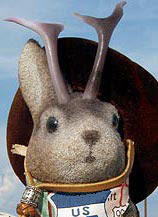
8 Comments:
Best. Post. Ever.
And although I am blissfully happy with my gorgeous little faux-Tudor cottage in Red Fork with the solar array on top and the henhouse and beehive out back, a little part of me is very, very sorry that I did not run off to California and spend part of my early 20s drifting from dingbat to dingbat in search of fame as a screenwriter....
Hey where are the pictures of the pretty girls? Don't tell me Ace Jack a Lope went to Las Vegas and did not get his photo taken with any show girls! The phot of the sign advertising the exotic dancers does't count.
JDP
Loved that post. Well done. And the first space dog, Laika, she's still up there. Jerky by now.
I'm intrigued, Emily. What would you have written? I saw a cool dingbat wth Polynesian lettering in Rosemead, CA, while on the way to Bahooka, a tiki restaurant, but was driving too fast in unfamiliar traffic to shoot it.
JDP, click on "2005" in the text under the Vegas sign.
Fathairybastard (oh man, Google's filters will love that name), according to the Cosmosphere, Laika burned up over the Pacific on April 14, 1958, having been dead since seven days into her flight.
How exactly she died has become a fogged issue. One story is that she was given a lethal injection from a syringe controlled from the ground. Another is that her last meal contained cyanide. According to the museum, The more likely theory is that she died from lack of oxygen.
Sergei Korolev, the Soviet "Chief Designer" is reported to have said "sleep peacefully, my little star farer, for you have done your job well."
I never liked hearing about cases like this, which is why I initially left the photo out of this post, but it went too well with the "Muttnik" reference to leave it out.
I just knew Ace would not let me down!
JDP
One of the hallmarks of Ace's site is the research you do. We learn from reading Ace's exploits. Scott Carpenter found out what your readers already know: Ace Jackalope truly has the right stuff.
Laika breaks my heart every time I think about her.
Ace: Probably a handful of sanctimonious, trying-to-be-avant-garde melodramas about women's issues, interspersed with a lot of shorter pieces along these lines:
"2 DCB
+ bac
+ T
+ g.o.
LFF
CS
LRB no ice
MDC
Thank you! :)
Emily"
Hi, i have a question about one of the sputniks.
i own a sputnik that i bought from my aunt for 40 dollars.
It's one of the "add on" sputniks.
you said you had one that blew off in a storm?
anyways. mine is like yours...except it only has blue spikes and is in a little better condition.
i was just wondering if you knew any information or estimation of value on it.
Thanks.
-luke.
Post a Comment
<< Home